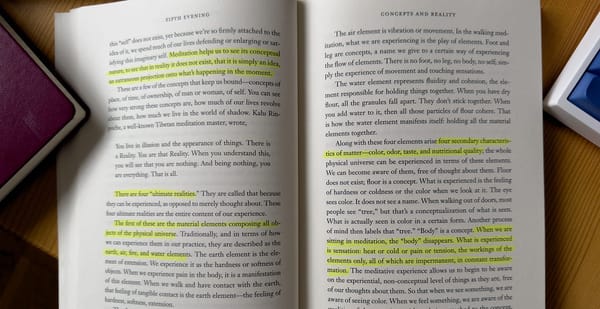Tana Basics - A Scratchpad That Organises Itself

In my first week of Tana, I focused on the basics and learning the core concepts of what it is, and how it differs from other outliners. You can read that post here.
This is a second in a series of blogs that I am writing, summarising my learnings of the Tana.Inc application. If you enjoy this blog, please considering following!
Since then, I’ve been looking at a lot of stuff that people have been creating online with Tana and specifically, their workflows. There are many templates available that do all the work for you and they are overloaded with options. As someone who has no issues with using templates for Adobe After Effects, I think that it’s fantastic that a relatively new application is building a passionate n and highly skilled community. There are already discord servers popping up with users along with the official community Slack which anyone is welcome to join.
I have a somewhat conflicted opinion of templates. I think they can be an great shortcut to getting what you need, but at the same time I think that by using a template you may also be giving yourself a disservice by not spending the time to learn how the template is built and how it works. And having chosen to learn Tana in a slow and methodical manner, using one of the templates (which also cost in some cases, upwards of $100) would not be advantageous to me whatsoever.
getting my hands dirty
Last time, it was all about the fundamentals. In this second blog, I’m getting my hands dirty. I had mentioned that I decided to move all my YouTube content management as well as blogs for Medium and the Not Entirely Boring newsletter. I started by simply creating a new node for each video or blog. In the simplest way, each node represents a project. Child nodes and then include a plethora of information. For example, I watched a really interesting video on the Wallace Line in Indonesia this week and that became a child node of that newsletter for 14th May (being the parent node).
In addition, I have found that because of the way in which supertags work, I don’t need to go into any of the live queries that I have saved in the sidebar, even when I need to update the status of a project. This has saved me so much time already. It’s actually incredible how easy this works. Let me show you…

the magic scratchpad
At the core of most outliners, including Tana, is the daily note; though I’m calling it a daily note, it’s not really a daily note - I call it my daily scratchpad. My daily magic scratchpad.
One of the customisations that I have seen some Tana users adopt is taking the #day supertag and adding loads of options. This gives you a new daily template each day. I have been conversing with other users on twitter, (who have been a huge help in both educating and supporting my Tana journey, thank you!) about the daily tag. What I found fascinating is that though some of the stuff I’d seen on YouTube overloaded the user with fields to complete each day on everything from tasks, to mental health - the general consensus was less options in the #day supertag means less to worry about. As I mentioned before, You should control your system, it shouldn’t control you.
The decision I made was to leave the supertag and do nothing with it. Because I am taking my Tana journey slow, I wanted to keep the daily scratchpad as that, a notepad that I add things to as I need to.
And this works because in Tana, there is no copy and pasting from other nodes, by using the @ to pull the node across I can simply update each node, or create new ones.

Part of the reason this is working for me, is that I don’t have think about anything as I write. My OCD of making sure everything is organised doesn’t come into play because by using a very few and simple supertags, of each of the areas the node relates to, Tana is able to organise them perfectly.
As you can see in the image below, for my YouTube content list, currently all I’m doing is putting the status of the video and the next task that is in the list. I would love to be able to automate the second list, but that will come later. This acts a bit of a dashboard and at a glance I can see where each video is up to (As you can see, I’m going to be busy editing for the next 6 months!)

But I don’t even have to go into this dashboard. I simply @ to pull the node in the scratchpad and it also pulls the child nodes, and I just update it.

I have included other fields as you can see, in preparation to extend the capability of the supertag, but for now, I’m keeping it simple.
simple supertags
If you’re new to Tana, I’d highly recommend taking a few recurring tasks that you have, and trying this method. I think that by having simple supertags to begin with you won’t overwhelm you new system. For the system I’m using the one supertag that I have begun to build out is the weekly newsletter. I actually start building content about 10 days before It’s published, sometimes I find that I have a lot of points and I have a ‘try not to exceed 2000 words’ rule and topics may get pushed to the following week. In Tana this supertag has status, an area to add topics and a quote. It’s not overly complex, but has enough fields to allow me to add stuff on the fly as I need to.

One of my favourite features of the supertag function is ‘hide when empty’ - this means that when I expand the node to show the fields I am not given a table with lots of empty cells. I get a small button to add the row once I have something to add to the node. It’s such a simple, but effective solution.
So this is how I’m starting my journey with Tana! I’m already saving time each day and feel very much in control of the system I have begun to build. However, I’m fully aware that I’ve only scratched the surface.
what’s next?
It’s very easy to get lost in a lot of brand new features that the YouTube algorithm simply can’t stop recommending me. I’m particularly interested to see how AI can be integrated to support with researching topics. (Though I’m still not entirely convinced by the accuracy) but I think that this feature is something I will look at later down the line. and though Obsidian is still my main application for the Zettelkasten, I think the next area I am going to be delving into is backlinking in Tana and to see how that works.
Thank you for reading to the end. Please consider subscribing to the Not Entirely Boring newsletter and following on Medium and YouTube.



